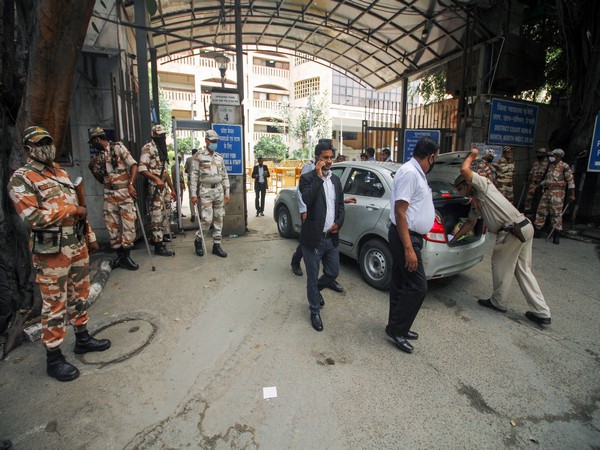


The Forensic Science Laboratory (FSL) in India's capital, New Delhi, has ruled out a terror angle in the explosion that occurred outside a school belonging to the Central Reserve Police Force (CRPF). The initial investigation revealed that the explosion was caused by a crude bomb, but no injuries were reported. A search operation is ongoing, with the FSL team and bomb disposal squad called to the scene.
CRPF: Ruling Out Terror Angle in School Blast
The Forensic Science Laboratory (FSL) in New Delhi has concluded that the explosion outside a Central Reserve Police Force (CRPF) school was not a terror attack. Initial investigations indicate that the blast was caused by a crude bomb, and no casualties were reported.
Background
The CRPF is India's largest paramilitary force, responsible for internal security and combatting terrorism. It operates a network of training schools and academies across the country, including the one in Delhi.
Incident Details
On [date of incident], an explosion occurred outside the CRPF school in Delhi's Burari area. The blast caused minor damage to the building, but there were no injuries. The FSL team and bomb disposal squad were immediately deployed to the scene.
Investigation
The FSL's investigation ruled out a terror angle. The examination of the blast site and the debris revealed that the explosion was caused by a small improvised explosive device. The bomb was likely assembled using locally available materials, such as gunpowder and detonators.
Search Operation and Security Measures
A search operation is ongoing in the area around the school. The FSL team and bomb disposal squad are conducting a detailed examination of the site to ensure that no further explosive devices are present. Additional security measures have been put in place by the CRPF to prevent any untoward incidents.
FAQs
1. What exactly happened in the incident? An explosion occurred outside a CRPF school in Delhi, causing minor damage but no injuries.
2. What caused the explosion? The blast was caused by a crude bomb, likely assembled using locally available materials.
3. Was it a terror attack? The FSL's investigation has ruled out a terror angle.
4. Are there any bomb threats or security concerns in the area? A search operation is ongoing, but no further explosive devices have been found. Additional security measures have been put in place by the CRPF.
5. What are the implications of this incident? The incident highlights the need for vigilance and robust security measures to prevent future attacks. It also underscores the importance of the CRPF's role in maintaining internal security and combatting terrorism.

A lone ISIS gunman ambushed a group of US service members and civilians in Syria, killing two and injuring three. The gunman was eventually killed by partner forces, confirmed by the US Defence Secretary. This is the first attack on US troops in Syria since the fall of President Bashar al-Assad. The casualties were transported to a nearby garrison and their identities will be withheld until their next of kin have been notified.

Pakistan's Prime Minister, Shehbaz Sharif, caused a major stir in Turkmenistan when he decided to gate-crash a meeting between Russian President Vladimir Putin and Turkish President Recep Tayyip Erdogan after waiting for 40 minutes. This impulsive move showcases Pakistan's increasing diplomatic insecurity and diminishing geopolitical clout. As Sharif struggles to secure meaningful engagements with major powers, he also faces domestic crises and is under the control of Army Chief Asim Munir. Meanwhile, the event in Turkmenistan marked a milestone for the country's declaration of neutrality and its efforts to maintain independence from both Western and Russian influence.

During an international forum in Turkmenistan, Pakistan's Prime Minister Shehbaz Sharif faced an embarrassing diplomatic moment as he walked into a private meeting between Russian President Vladimir Putin and Turkish President Recep Tayyip Erdogan. Sharif had been waiting for over 40 minutes for his scheduled meeting with Putin, causing him to enter the ongoing conversation between the two leaders. The incident, captured on video and shared by RT India, has triggered widespread mockery on social media with users making jokes about Sharif's actions. This comes as Pakistan attempts to strengthen its ties with Russia, while Putin maintains a closer relationship with India.

The latest bout of border fighting between Thailand and Cambodia has escalated, with hundreds of thousands of civilians displaced and casualties on both sides. The renewed skirmishes have shattered a ceasefire proposed by U.S. President Donald Trump in July. The leaders of both countries have promised to continue their aggressive stance, causing further tension and concerns for the safety of civilians. This has even resulted in the withdrawal of Cambodia's team from a regional sporting event.

Notorious Naxalite commander Ramdher Majji, along with his group, surrendered to the police in Chhattisgarh. This surrender marks a milestone in the fight against Naxalism, as the state's Deputy Chief Minister states that 80 percent of the menace has been eradicated. With the government's resolved aim to eliminate Naxalism by 2026, the country is heading towards a permanent solution to this long-standing issue. Home Minister Amit Shah also noted the significant progress made in reducing Naxal violence, with only 10 percent of the nation's population currently affected compared to 120 million people in the past.

After the tragic fire at their club in Goa, owners Gaurav and Saurabh Luthra have been detained in Thailand and are expected to be brought back to India soon. The Indian agencies have been in constant communication with Thai authorities and have managed to locate the brothers outside the main city area. With their detention, the process for their deportation has been initiated and Indian agencies are coordinating with Thai authorities for their return. The article also explains the general procedure for deportation of foreigners from Thailand under immigration laws.

Two years after the shocking death of Dawn Sturgess from Novichok poisoning, a public inquiry has released its final report. The report, overseen by retired Supreme Court justice Lord Hughes of Ombersley, examined whether British officials had taken adequate precautions to prevent the attack on ex-spy Sergei Skripal and his daughter Yulia in March 2018. The inquiry also investigated whether Ms. Sturgess's death could have been avoided with timely public warnings about abandoned objects. Good Morning Britain correspondent Richard Gaisford reported live from Salisbury, where the attack first came to light, to reveal the disturbing findings of the inquiry.

The Indian Air Force (IAF) has found a solution to maintain its aging Jaguar fleet by obtaining over 20 retired aircraft from the Oman Air Force. These jets will be dismantled and used as spares, as global production of Jaguar has ceased. With this transfer, India will become one of the few countries to still operate the Anglo-French supersonic attack aircraft. The collaboration between India and Oman in this regard reflects their robust defense partnership.

In a monumental decision, UNESCO has officially named India's beloved festival of lights, Deepavali, to its prestigious Intangible Cultural Heritage List during a committee meeting at the iconic Red Fort in Delhi. The news was met with joyous celebrations and performances, with Prime Minister Modi expressing his pride and noting the global impact of Deepavali's inclusion. This marks the sixteenth element from India to be inscribed on the Representative List, solidifying the country's rich cultural heritage.

India's festival of lights, Deepavali, has been added to Unesco's list of Intangible Cultural Heritage, following in the footsteps of Durga Puja. Prime Minister Narendra Modi expressed his delight at the nomination, stating that the festival is closely tied to India's culture and ethos. The nomination process for Deepavali involved diverse communities and experts, showcasing the festival's reach beyond the country, as it joins India's 15 elements already on Unesco's list.